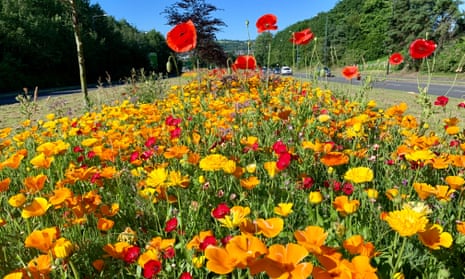It was a startling picture. An eight-mile river of colour flows where once a dry bed of stubby grass grew – all because a local authority rewilding strategy brought country life back to an urban landscape. The stretch of roadside verges in and around Rotherham, South Yorkshire, planted with wild flowers for the third year running, created national news last month: photographs showing the profusion of poppies, cornflowers and corn marigolds set amid the concrete and brick landscape of the town’s ring road made for a dramatic juxtaposition. Who knew a central reservation could be transformed into a colourful mini-idyll for human eyes and local insects too?
It is a reminder that nature has a gift for giving. As our readers have shown by sharing their photos, meadow planting is having a moment. Aberdeen council and Highways England, which manages 30,000 hectares of green space across England, are considering following the example set by Rotherham, Nottinghamshire and cities including Birmingham, Sheffield and Manchester. Life on Earth has an intrinsic value, is of spiritual importance and contains an aesthetic beauty that defies being quantified. But there’s no doubt it helps that rewilding, often associated with grand schemes such as the reintroduction of species, can be as cheap as chips. Rotherham council’s new system has led to savings on mowing costs of £23,000 a year.
The new style of planting is not confined to public spaces. Awareness of the threat to insects and other wildlife from pesticides and global heating is growing, and along with it a new enthusiasm among gardeners for planting that does something to help. When amateur gardener Peter Thain turned his Cheltenham front garden into a homemade meadow his social media posts received a rapturous response. In the past ecologists and gardeners have often not seen eye to eye, with the former’s disapproval of the use of pesticides, herbicides and peat, and emphasis on native species, anathema to the plantsman or -woman whose chief interest is visual display.
But with the biodiversity crisis pressing in, attitudes are changing. Gardens, like verges and other open spaces, are increasingly recognised as important habitats for the bees and other pollinators on which we all depend. Gardeners are learning not to be so tidy; to recognise that butterflies bring more to the landscape than manicured edges; that every weed does not need to be torn out.
The change is not all on one side. Where ecology used mainly to be associated with rural landscapes, practitioners have shifted their focus to urban settings where many have embraced planting schemes that incorporate non-native species alongside native ones. Such projects are not an alternative to change in the countryside. The government has pledged to put “environmental enhancement” at the heart of agricultural policy, and this change cannot come too soon. As Michael Gove, the environment secretary, made clear this week, new international targets for nature conservation will have to be agreed by 2020. What the wildflower displays in Rotherham and elsewhere show us is that the transition to a greener way of life is not only possible but sometimes pleasant too.
